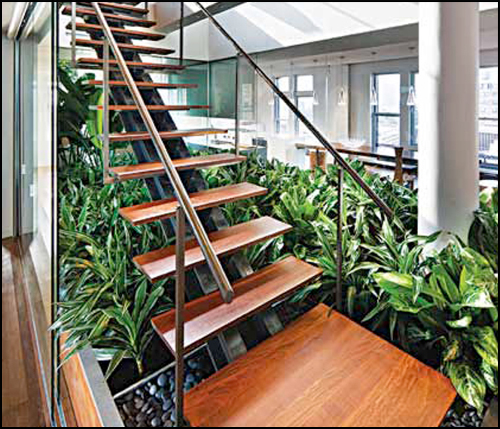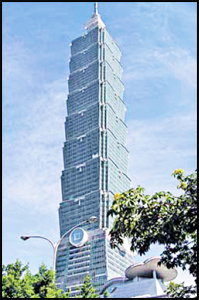MAY 2012: Construction and functioning of buildings has a profound effect on the environment. Buildings account for 40 per cent of our total energy requirements. These need to save energy, in order to reduce CO2 output and protect the environment.
In view of this, constructing green buildings is becoming a standard practice today. Compared to conventional buildings, a green building promotes healthier living spaces for the occupants while ensuring that utility wastage (water, energy and other natural resources) is minimal.

A smart green building can be described as the convergence of technology and real estate applications. Devices and solutions are transferred onto a converged IP network disrupting traditional design, transforming the physical space into a service offering.
Integrated energy management systems support sophisticated power management and energy conservation, leading to long-term environmental sustainability. Lighting automation solutions are delivered over the converged IP network. Centralised monitoring and control of elevators, heating, ventilation and cooling (HVAC), and facilities help ensure that the building meets or even exceed performance standards. An added benefit is that with the knowledge of energy usage patterns, building operators can respond to power cuts and proactively manage the carbon footprint to build a sustainable and more energy-efficient environment.
Converging multiple functions onto system devices means reducing the number of IT equipment needed, use of systems that consume less power, and more efficient use of all equipment. This, in turn, makes a significant difference in operating costs.
What goes inside
The most advanced green buildings deploy a host of IT and electronic elements including wired and wireless networks, network controllers, BACnet and local operating network routers, gateways, automation controllers, sensors and sensor network controllers, variable air volume controllers, servers, workstations and browsers. The variety and performance of these components depend on the level of complexity of the building automation systems.
Controls and automation, sensors and energy-efficient lighting are the most important components of a green building.
Control and automation solutions help save on illumination costs. These allow integration of a range of services within a space, such as lighting, security, heating, ventilation, air-conditioning, home theatre, audio, motorised curtains and blinds. This gives the user the option of restricting the use of a product to only when it is required.
Sensors can detect motion in a room or the level of available natural light, and adjust artificial lighting
levels suitably. These can also pick up infrared commands from remote controls for added flexibility.
LED lighting is highly energy-efficient. It is one of the most sustainable and longest lasting lighting sources available today. It facilitates reduction in CO2 emissions, in addition to saving energy and maintenance costs.
[stextbox id=”info” caption=”Taipei 101, the world’s tallest green building”]
Taipei 101 building in Taiwan has achieved a 10 percent saving in electricity usage,water  consumption and waste over the past two years. Its energy consumption is 30 per cent more efficient than an average building. All of this results in approximately $700,000 of savings in annual energy costs.
consumption and waste over the past two years. Its energy consumption is 30 per cent more efficient than an average building. All of this results in approximately $700,000 of savings in annual energy costs.
The building has a fully integrated energy management and control system installed.Intelligent connectivity enables the integration of power monitoring,generator management, chiller control, lighting control, zone pump variable-speed drive security management, fire alarm systems and car parkingmanagement. Time controls have been placed on extractor fans that previously ran continuously.Every thermostat and variable air volume box was placed after identifying a location for it.
The energy monitoring and control system by Siemens streamlines the operation and control of the HVAC equipment throughout the complex, optimising the entire energy usage. The efficiency of the cooling system has been increased by applying improved algorithms for the chiller plant and changing the sequence of operation.
(Source: Case study-Siemens helps TAIPEI 101 to become the tallest ‘green’ building in the world)
[/stextbox]
Most green buildings today work with independently controlled and managed lighting, HVAC and other loads. Some very advanced buildings provide loose integration at the data visualisation or dashboard level. This allows continuous monitoring of the different loads and corrective actions as and when desired. Some of these advanced systems allow interfacing with the utility grids, and present opportunities of demand response and dynamic energy pricing.
Intelligent IP-based networking
Using green networking solutions reduces not only networking costs but also general operating expenses such as office space and energy costs.
Cisco has designed an end-to-end solutions system to ensure effectiveness of green buildings. Its Smart+Connected utilities solutions use an intelligent IP-based network platform to address energy, water, and gas management and consumption, and thereby reduce carbon emissions, and increase efficacy. Building managers can plan and manage energy consumption based on real-time information and policy configurations.
The network building mediator provides the intelligence to interconnect and enable building systems such as HVAC, lighting, electrical, security, and renewables over the IP network to build smart and energy-efficient buildings of the future. NetApp has deployed this solution in conjunction with other systems and reduced energy consumption at its Sunnyvale location (USA) by 18 million kilowatt hours in 18 months. Apart from a reduced carbon footprint, the company has saved an estimated $2 million in energy costs.









